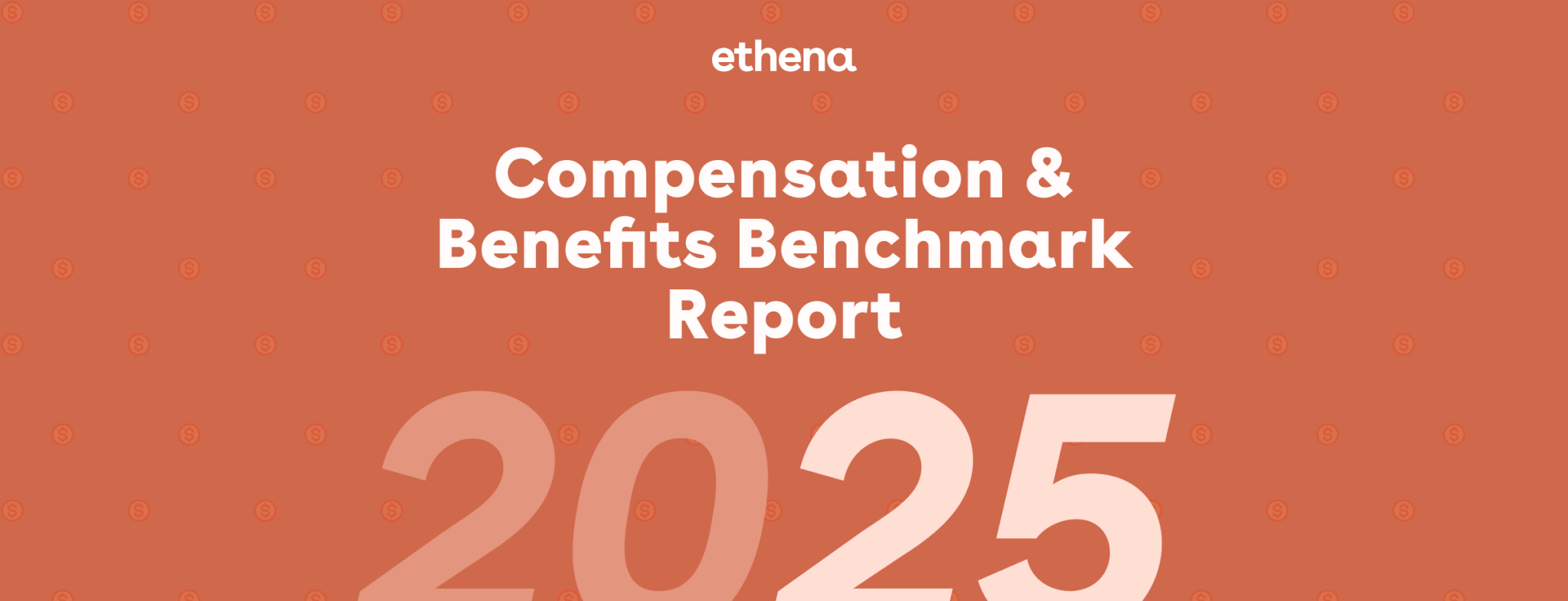"What are our peers doing?"
It's the question every CEO asks their HR team when a proposal's on the table. And rightly so — understanding what peer companies are doing is critical to understanding where you stand in the market. Are you breaking the mold or staying aligned with your industry? If you're breaking the mold, do you have a solid business justification for doing so? Equipping yourself with market data is critical to making key strategic decisions (and winning buy-in along the way.)
Enter: Ethena's 2025 Compensation & Benefits Benchmark Report.
About the report
Ethena and LifeLabs Learning partnered up to survey nearly 500 HR professionals on how their organization structures compensation, health insurance, vacation/PTO, flex work, and parental leave benefits. We pulled this data into a report that provides a look at emerging trends in these areas, so you can make the best, most-informed decisions for your employees and your bottom line.
Audience demographics
- 490 HR professionals across 15 industries, including Software/Technology, Professional Services, Non-Profit, Healthcare, and Construction & Manufacturing
- 40% of companies surveyed were fully remote
- 52% of respondents were Director-level or higher
What are HR benchmarks?
HR benchmarks are data points or industry standards that provide insights into how similar companies structure their benefits. They usually include stats like:
- Average healthcare costs per employee
- Percentage of companies offering flexible work schedules
- Commonly offered perks across industries (e.g., wellness stipends, learning budgets)
But choosing the right benefits for your organization isn’t about keeping up with the Joneses — it's about aligning them with your business needs and people philosophies. Benchmarks are an invaluable part of this process because they help HR teams assess what’s realistic and impactful based on their unique workforce and goals.
Let’s explore four common People-related goals and how benchmarks can help.
Focused on one of the below goals this year? This report is for you.
Goal: Attract and retain talent
Think of HR benchmarks as a cheat sheet for knowing what’s standard — and what’s standout — when it comes to employee benefits, salaries, and perks. If you know your competitors are offering things like fertility benefits and 401(k) matching, you can make sure you’re staying in the game.
Even better, you can identify where to one-up them (hello, pet insurance or a wellness stipend!)
Goal: Optimize budget allocation
Here’s where benchmarking can save your bacon. It tells you what’s worth spending on and what’s just fluff. For instance, if benchmarks show that unlimited PTO isn’t driving retention for companies your size, maybe you pivot to offering more robust parental leave or flexible hours instead.
It’s like grocery shopping with a list: you don’t throw everything in your cart just because you’re hungry. Instead, you’re investing in benefits that employees actually care about and that align with your company’s goals.
Goal: Improve fairness and transparency
Like it or not, employees talk about their pay. Benchmarking lets you make sure your salary ranges are fair and competitive, so you don’t end up on the wrong side of a Glassdoor review. It also supports pay transparency initiatives. When you can confidently say, “Here’s how we landed on this salary range, based on market data,” it builds trust. Plus, it helps you stay compliant with evolving pay transparency laws in places like California and New York.
Goal: Support employee engagement
Benchmarking is a reality check on whether your benefits and policies actually “click” with employees. When you match or exceed what’s common in your industry, employees feel like you’re investing in their well-being. If benchmarks show that mental health resources are trending in your industry, but you haven’t implemented anything beyond an EAP, you might consider adding something like subsidized therapy or mindfulness apps.
Download the report now!
Whether you’re looking to refine your recruitment processes, enhance employee benefits, or ensure compliance, the insights from this report will help guide your most important strategic HR decisions in 2025. Get your free copy of Ethena's 2025 HR Compensation & Benefits Benchmark Report.








